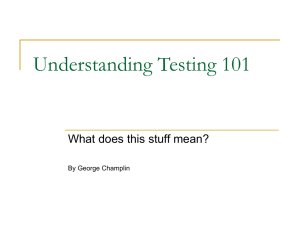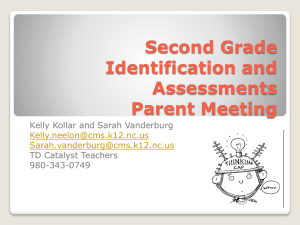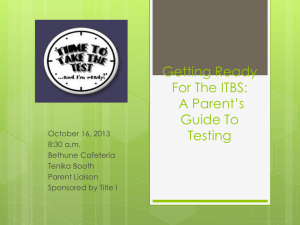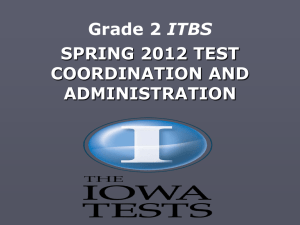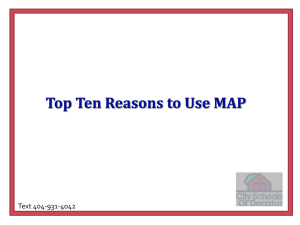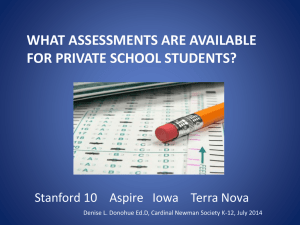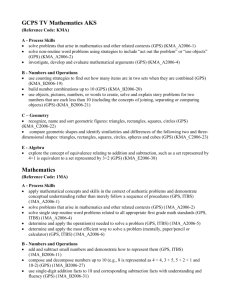ITBS Overview presentation OC final rev 1-15-13
advertisement
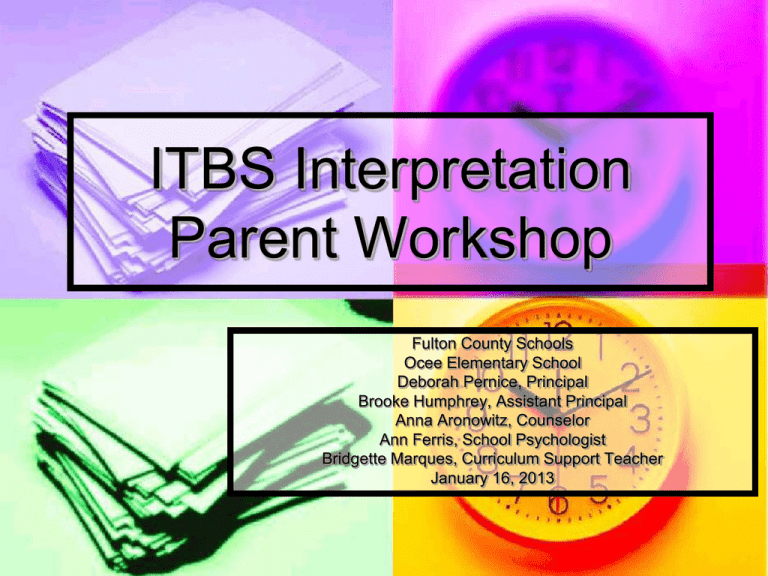
ITBS Interpretation Parent Workshop Fulton County Schools Ocee Elementary School Deborah Pernice, Principal Brooke Humphrey, Assistant Principal Anna Aronowitz, Counselor Ann Ferris, School Psychologist Bridgette Marques, Curriculum Support Teacher January 16, 2013 What does all this mean? 2 What is ITBS? Iowa Tests of Basic Skills (ITBS) Norm-referenced tests - Georgia law mandates that a nationally norm-referenced test, such as the ITBS, be administered annually to students in grades three and eight. Fulton County adds grade five. The purpose of a norm-referenced test is to obtain information about the performance of Georgia's students and compare it with that of students in a national sample. The results are used for evaluation, decision-making, and to guide instruction. Understanding the scores - The scores are reported in percentiles and show how students compare with other students across the nation. For example, if a student received a score of 66%, that means the student performed better than 66% of all the students in the nation of the same grade level who took the test. 3 Interpreting Test Scores 3 Fundamental Purposes of ITBS are: 1. 2. 3. To describe each student’s developmental level within a test area. To identify a student’s areas of relative strengths and weaknesses in subject areas. To monitor year-to-year growth in the basic skills. 4 Types of Scores Standard Score (SS) Describes a student’s location on an achievement continuum. For the ITBS, this continuum goes from 150 for 1st grade to 250 for 8th grade. By itself, the standard score has little, or no, meaning. 1 2 3 4 5 6 7 8 150 168 185 200 214 227 239 250 5 Types of Scores continued Grade Equivalent (GE) Describes student’s location on an achievement continuum The higher the number, the higher the level of knowledge or skill. Digits to left of decimal point indicate grade and those to right indicate month. For example, if a 5th grade student obtains a GE of 7.6 on the Vocabulary test, his/her score is comparable to that of a typical student finishing the 6th month of the 7th grade. GEs are NOT prescriptions for grade placement; GEs represent estimates of developmental level, or year-to-year growth. 6 Types of Scores continued National Stanine (NS) Ranges from 1-9. For example, a student with a stanine score of 5 scored in the average range. 7 Types of Scores continued National Percentile Rank (NPR) Reflects the student’s relative position or rank in a group of students who are in the same grade and were tested at the same time of year as the student. A NPR of 80% means that the student scored higher than 80 percent of the students in the comparison group, and that 20 percent scored higher than he/she did. NPRs range from 1 to 99. 8 Types of Scores continued Percent Correct (PC) PC =(Raw Score/Total # of Q’s) X 100. Also meaningless by itself (unless we know the overall difficulty of the test.) PC scores are NOT the same thing as percentile ranks. 9 Norm-Referenced Interpretation How much a student knows is determined by the student’s standing or rank within the reference group. High standing is interpreted to mean a student is highly skilled, and low standing means the opposite. Norms allow for student to student and school to school comparisons. Time of year tested should not affect PR (e.g., PR of 60 in Fall or Spring), but will affect GE. Only indicates relative standing, not what a student knows or doesn’t know. 10 Interpreting Scores from Special Test Administrations A testing accommodation is a change in procedure for administering a test that is intended to neutralize the effect of a student’s disability on the assessment process. Use of accommodations should help the student experience the same conditions as those in the reference group. Examples are small group setting, extended time, large print, etc. 11 Descriptions of ITBS Tests Vocabulary – This section measures general vocabulary content. Students are presented with a word in the context of a short phrase or sentence, and they are to select the answer that most nearly means the same as that word. There is approximately an equal number of nouns, verbs and modifiers tested. 12 Descriptions of ITBS Tests Reading Comprehension – This section presents students with a variety of passages that vary in length. Included are fiction, fables, tales, poetry, interviews, diaries, and other non-fiction. Approximately two-thirds of the questions require students to draw inferences or to generalize about what they have read. 13 Descriptions of ITBS Tests Spelling – This section measures a student’s ability to recognize common spelling errors such as substitutions, reversals, omissions, or unnecessary additions. Each spelling question presents four words, one of which may be misspelled, and a fifth option, No Mistakes, for use when all four words are spelled correctly. 14 Descriptions of ITBS Tests Capitalization – This section requires students to identify errors— undercapitalization or overcapitalization—presented in brief written contexts. Capitalization of names and titles, dates and holidays, places, organizations and groups, and other words is tested. 15 Descriptions of ITBS Tests Punctuation – The questions in this section require students to identify errors in punctuation. Questions relate to the use of terminal punctuation, commas, apostrophes, quotation marks, colons, and semicolons. 16 Descriptions of ITBS Tests Usage and Expression – This section has two parts. The first part measures a student’s knowledge of the use of verbs, personal pronouns, and modifiers. The second part requires students to choose the best or most appropriate way of expressing an idea that has been presented as a sentence or a paragraph. 17 Descriptions of ITBS Tests Math Concepts and Estimation The first part of this test, Math Concepts, requires students to demonstrate an understanding of math ideas, relationships, and visual representations such as number properties and operations, algebra, geometry, measurement, and probability and statistics. The second part, Estimation, is on computational estimation and number sense. Each question requires the use of one of several rounding or estimation methods. 18 Descriptions of ITBS Tests Math Problem Solving and Data Interpretation – This sections measures a student’s ability to solve word problems that require one or more steps and to interpret data in tables and graphs. Several “real-world” stories form the basis for the 3-4 word problems. Data are presented in tables and graphs, and students must use the data displays to obtain information, compare quantities, and determine trends or relationships. 19 Descriptions of ITBS Tests Math Computation – This section requires students to use one arithmetic operation—addition, subtraction, multiplication, or division. Problems require operations with whole numbers, fractions, decimals, and various combinations of these. Students must work problems and compare their answers with the choices given. 20 Descriptions of ITBS Tests Social Studies – This section measures objectives of the social studies curriculum. Emphasis is on the use and understanding of concepts, principles, and selected types of visual materials. Content of questions is drawn from the areas of history, geography, political science, economics, sociology, and anthropology. 21 Descriptions of ITBS Tests Science – This section measures knowledge and skills in the areas of life science, earth and space sciences, and physical sciences. Maps and Diagrams – In this section, a variety of maps representing authentic locations is used to measure students’ abilities to use maps for multiple purposes. Other questions on the test use charts and diagrams to measure a student’s ability to understand information presented visually. 22 Descriptions of ITBS Tests Reference Materials – This test measures the ability to use reference materials and library resources to obtain information. Students must have a knowledge of information sources and a command of strategies for using those sources. Questions are about using search strategies, keywords, a dictionary, and general reference materials. At the fifth grade level, additional skills that are tested include note-taking and using electronic sources and an index. 23 Now that I know what all this means, how can I help my child? 24 If your child is low in: Vocabulary Read to him/her daily. Encourage your child to recognize new vocabulary. Have increased conversations with your child about word meanings. Limit time spent in non-participant activities (TV, video games, etc.) Encourage daily independent reading. 25 If your child is low in: Reading Comprehension Have your child silently read a chapter then retell the chapter. If your child is struggling with the longer passages, chunk passages into manageable sections. With Social Studies and Science assignments, have your child read the questions first, find the key words in the questions, then go back into text to find answers. Encourage your child to read books independently at his/her Lexile level. Read books to or with your child that are above his/her Lexile level. 26 If your child is low in: Spelling Look for patterns in spelling and work with him/her on improving these patterns. 27 If your child is low in: Capitalization and Punctuation Your child should reread his/her work and be encouraged to find the mistakes in the work. 28 If your child is low in: Usage and Expression Have your child journal at home about various activities (vacations, trips, holidays, etc.) Using the journal, have conversations with your child about sentence structure, verb tenses, proper punctuation, etc. 29 If your child is low in: Math Utilize computer programs and websites. Work with your child using flash cards. Use daily life experiences to help practice with your child. 30 What is Ocee’s plan for student success? 31 ITBS – 3rd Grade Fall 2009 - 2012 Rdg. 2009 Rdg. 2010 Rdg. 2011 Rdg. 2012 Math 2009 Math 2010 Math 2011 Math 2012 Abbotts Hill 75 71 76 79 83 80 89 88 Barnwell 84 77 81 83 85 80 91 88 Dolvin 78 75 83 82 86 81 90 86 Findley Oaks 80 79 83 83 88 82 92 90 Medlock Bridge 83 81 85 82 89 81 91 90 Ocee 77 79 82 83 82 80 91 89 State Br. Crossing 74 78 80 83 84 85 90 88 Wilson Creek 77 73 83 82 65 70 91 90 ITBS – 5th Grade Fall 2009 - 2012 Rdg . 2009 Rdg . 2010 Rdg. 2011 Rdg. 2012 Math 2009 Math 2010 Math 2011 Math 2012 Abbotts Hill 81 76 79 78 86 80 86 85 Barnwell 85 78 82 82 88 74 88 88 Dolvin 81 84 81 80 81 84 87 86 Findley Oaks 83 81 87 85 85 87 92 90 Medlock Bridge 82 80 85 84 86 82 90 90 Ocee 74 81 84 82 77 85 90 89 State Br. Crossing 75 75 82 84 79 80 88 89 Wilson Creek 85 77 84 79 81 85 91 87 Steps we’ve taken: A review of the data by the administrative team, the leadership team, and grade level teams Based on this data analysis, teachers are improving instruction through standardsbased learning. Data used to identify students who need assistance (i.e., Team Time, Extended Team Time, Math Mania, Extended Learning-M/R Club) 34 Ocee’s plan of action: Test-taking strategies using both ITBS prep materials and guidance lessons are being taught to students in all grades. Teachers are exposing students more to ITBS language, particularly in 2nd grade. The Scholastic Reading Inventory (SRI) is administered to students to ascertain their Lexile levels, and reading instruction is adjusted accordingly. 35 Questions and Concerns? Thank you for coming and for your continued support of our students! 36
